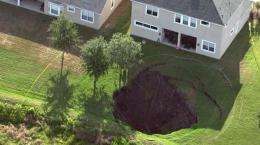A sinkhole formed feet away from a home in Windermere, Fla. on May 3.
A sinkhole, about 100-feet-wide and 50-feet-deep, opened up in the backyard of a home in a Windermere, Fla. May 3. Almost one week later, another sinkhole that was 80-feet-long and 40-feet-wide opened in the backyard of a home in Jonesville, Fla.
A sinkhole is a natural depression or hole in the Earth’s surface that is caused by the dissolution of carbonate rocks. According to Grenville Draper, professor in the Department of Earth and Environment, rain is not necessary for a sinkhole to form, but a period of intense rain after a drought can trigger one.
“A sinkhole can open in a matter of hours, that’s why there’s a dramatic element to them,” Draper said. “Most times, we can’t really predict when and where a sinkhole will occur.”
Florida bedrock is made almost entirely of limestone. A sinkhole occurs when that limestone dissolves, Draper said.
“Groundwater dissolves the limestone upwards, forming a type of cave or cavity,” he said. “Once that cavity reaches the top of the limestone, loose surrounding sand falls back into that cavity, kind of like sand running through an hourglass. That’s when you have sinkhole.”
Sinkholes can happen worldwide. The largest are currently found in New Guinea and Venezuela in South America. They are also common in Michigan, Kentucky and Tennessee. As for Florida, Draper says sinkholes are not uncommon, but occur more often in the central part of the state.
Provided by Florida International University























